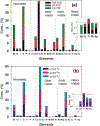Material recovery from electronic waste using pyrolysis: Emissions measurements and risk assessment
- PMID: 33747764
- PMCID: PMC7970511
- DOI: 10.1016/j.jece.2020.104943
Material recovery from electronic waste using pyrolysis: Emissions measurements and risk assessment
Abstract
Electronic waste (e-waste) generation has been growing in volume worldwide, and the diversity of its material composition is increasing. Sustainable management of this material is critical to achieving a circular-economy and minimizing environmental and public health risks. This study's objective was to investigate the use of pyrolysis as a possible technique to recover valuable materials and energy from different components of e-waste as an alternative approach for limiting their disposal to landfills. The study includes investigating the potential environmental impact of thermal processing of e-waste. The mass loss and change in e-waste chemicals during pyrolysis were also considered. The energy recovery from pyrolysis was made in a horizontal tube furnace under anoxic and isothermal conditions of selected temperatures of 300 °C, 400 °C, and 500 °C. Critical metals that include the rare earth elements and other metals (such as In, Co, Li) and valuable metals (Au, Ag, Pt group) were recovered from electronic components. Pyrolysis produced liquid and gas mixtures of organic compounds that can be used as fuels. Still, the process also emitted particulate matter and semi-volatile organic products, and the remaining ash contained leachable pollutants. Furthermore, toxicity characteristics leaching procedure (TCLP) of e-waste and partly oxidized products were conducted to measure the levels of pollutants leached before and after pyrolysis at selected temperatures. TCLP result revealed the presence of heavy metals like As, Cr, Cd, and Pd. Lead was found at 160 mg/L in PCBs leachate, which exceeded the toxicity characteristics (TC) limit of 5 mg/L. Liquid sample analysis from TCLP also showed the presence of C10-C19 components, including benzene. This study's results contribute to the development of practical recycling alternative approaches that could help reduce health risks and environmental problems and recover materials from e-waste. These results will also help assess the hazard risks that workers are exposed to semi-formal recycling centers.
Keywords: E-waste recycling; Heavy metals; Metals recovery; Organic pollutants; Pyrolysis; VOC/PAH emission and health risks.
Figures










Similar articles
-
The Minderoo-Monaco Commission on Plastics and Human Health.Ann Glob Health. 2023 Mar 21;89(1):23. doi: 10.5334/aogh.4056. eCollection 2023. Ann Glob Health. 2023. PMID: 36969097 Free PMC article. Review.
-
Changes in chlorinated organic pollutants and heavy metal content of sediments during pyrolysis.Environ Sci Pollut Res Int. 2007 Jan;14(1):12-8. doi: 10.1065/espr2006.07.322. Environ Sci Pollut Res Int. 2007. PMID: 17352123
-
Concentration of precious metals during their recovery from electronic waste.Waste Manag. 2016 Nov;57:121-130. doi: 10.1016/j.wasman.2015.12.004. Epub 2015 Dec 23. Waste Manag. 2016. PMID: 26712661
-
Combined disc pelletisation and thermal treatment of MSWI fly ash.Waste Manag. 2018 Mar;73:381-391. doi: 10.1016/j.wasman.2017.12.020. Epub 2017 Dec 20. Waste Manag. 2018. PMID: 29273540
-
An Overview of Characterisation, Utilisation, and Leachate Analysis of Clinical Waste Incineration Ash.Int J Environ Res. 2022;16(5):69. doi: 10.1007/s41742-022-00455-0. Epub 2022 Aug 16. Int J Environ Res. 2022. PMID: 35992579 Free PMC article. Review.
Cited by
-
Degradation of tetrabromobisphenol A (TBBA) with calcium hydroxide: a thermo-kinetic analysis.RSC Adv. 2023 Feb 28;13(10):6966-6982. doi: 10.1039/d2ra08223c. eCollection 2023 Feb 21. RSC Adv. 2023. PMID: 36865571 Free PMC article.
-
Selective Gold Precipitation by a Tertiary Diamide Driven by Thermodynamic Control.Inorg Chem. 2024 May 20;63(20):9332-9345. doi: 10.1021/acs.inorgchem.4c01279. Epub 2024 May 9. Inorg Chem. 2024. PMID: 38722710 Free PMC article.
-
Prediction of Thermogravimetric Data in the Thermal Recycling of e-waste Using Machine Learning Techniques: A Data-driven Approach.ACS Omega. 2023 Oct 30;8(45):43254-43270. doi: 10.1021/acsomega.3c07228. eCollection 2023 Nov 14. ACS Omega. 2023. PMID: 38024703 Free PMC article.
-
Glassy Powder Derived from Waste Printed Circuit Boards for Methylene Blue Adsorption.Molecules. 2024 Jan 13;29(2):400. doi: 10.3390/molecules29020400. Molecules. 2024. PMID: 38257313 Free PMC article.
References
-
- Chandrasekaran SR, et al., Materials and energy recovery from e-waste plastics. 6 (4) 2018, 4594–4602.
-
- Electronic Take Back Coalition, f.a.f. Facts and Figures on E-Waste and Recycling. 2014. http://www.electronicstakeback.com/wp-content/uploads/Facts_and_Figures_.... (Cited 25 July 2019).
-
- EUROSTAT. Waste Electrical and Electronic Equipment (WEEE) by Waste Management Operations. 2014. http://epp.eurostat.ec.europa.eu/portal/page/portal/statistics/search_da.... (Cited 25 July 2019).
-
- UN. Report: Time to Seize Opportunity, Tackle Challenge of E-waste 2019. https://www.unenvironment.org/news-and-stories/press-release/un-report-t.... (Cited 25 July 2019).
-
- Diaz-Barriga F, Evidence-based intervention programs to reduce children’s exposure to chemicals in e-waste sites. in: Discussion Paper for WHO Working Meeting on E-waste and Children’s Health. 2013.
Grants and funding
LinkOut - more resources
Full Text Sources
Other Literature Sources
Research Materials
Miscellaneous
